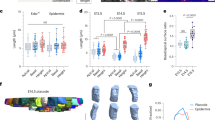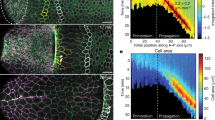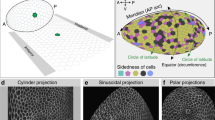Abstract
The morphogenesis of organs as diverse as lungs, teeth and hair follicles is initiated by a downgrowth from a layer of epithelial stem cells1,2. During follicular morphogenesis, stem cells form this bud structure by changing their polarity and cell–cell contacts. Here we show that this process is achieved through simultaneous receipt of two external signals: a Wnt protein to stabilize β-catenin, and a bone morphogenetic protein (BMP) inhibitor to produce Lef1. β-Catenin then binds to, and activates, Lef1 transcription complexes that appear to act uncharacteristically by downregulating the gene encoding E-cadherin, an important component of polarity and intercellular adhesion. When either signal is missing, functional Lef1 complexes are not made, and E-cadherin downregulation and follicle morphogenesis are impaired. In Drosophila, E-cadherin can influence the plane of cell division and cytoskeletal dynamics3. Consistent with this notion, we show that forced elevation of E-cadherin levels block invagination and follicle production. Our findings reveal an intricate molecular programme that links two extracellular signalling pathways to the formation of a nuclear transcription factor that acts on target genes to remodel cellular junctions and permit follicle formation.
This is a preview of subscription content, access via your institution
Access options
Subscribe to this journal
Receive 51 print issues and online access
$199.00 per year
only $3.90 per issue
Buy this article
- Purchase on Springer Link
- Instant access to full article PDF
Prices may be subject to local taxes which are calculated during checkout




Similar content being viewed by others
References
Hardy, M. H. The secret life of the hair follicle. Trends Genet. 8, 55–61 (1992)
Hogan, B. L. Morphogenesis. Cell 96, 225–233 (1999)
Jan, Y.-N. & Jan, L.-Y. Asymmetric cell division in the Drosophila nervous system. Nature Rev. Neurosci. 2, 772–779 (2001)
van Genderen, C. et al. Development of several organs that require inductive epithelial-mesenchymal interactions is impaired in LEF-1-deficient mice. Genes Dev. 8, 2691–2703 (1994)
Zhou, P., Byrne, C., Jacobs, J. & Fuchs, E. Lymphoid enhancer factor 1 directs hair follicle patterning and epithelial cell fate. Genes Dev. 9, 700–713 (1995)
Gat, U., DasGupta, R., Degenstein, L. & Fuchs, E. De novo hair follicle morphogenesis and hair tumors in mice expressing a truncated β-catenin in skin. Cell 95, 605–614 (1998)
DasGupta, R. & Fuchs, E. Multiple roles for activated LEF/TCF transcription complexes during hair follicle development and differentiation. Development 126, 4557–4568 (1999)
Huelsken, J., Vogel, R., Erdmann, B., Cotsarelis, G. & Birchmeier, W. β-catenin controls hair follicle morphogenesis and stem cell differentiation in the skin. Cell 105, 533–545 (2001)
Hirai, Y., Nose, A., Kobayashi, S. & Takeichi, M. Expression and role of E- and P-cadherin adhesion molecules in embryonic histogenesis. II. Skin morphogenesis. Development 105, 271–277 (1989)
Gumbiner, B. M. Regulation of cadherin adhesive activity. J. Cell. Biol. 148, 399–404 (2000)
Daniels, D. L., Eklof-Spink, K. & Weis, W. I. β-catenin: molecular plasticity and drug design. Trends Biochem. Sci. 26, 672–678 (2001)
Brantjes, H., Barker, N., van Es, J. & Clevers, H. TCF: Lady Justice casting the final verdict on the outcome of Wnt signalling. Biol. Chem. 383, 255–261 (2002)
Chan, S.-K. & Struhl, G. Evidence that Armadillo transduces Wingless by mediating nuclear export or cytosolic activation of pangolin. Cell 111, 265–280 (2002)
St-Jacques, B. et al. Sonic hedgehog signaling is essential for hair development. Curr. Biol. 8, 1058–1068 (1998)
Reddy, S. et al. Characterization of Wnt gene expression in developing and postnatal hair follicles and identification of Wnt5a as a target of Sonic hedgehog in hair follicle morphogenesis. Mech. Dev. 107, 69–82 (2001)
Kratochwil, K., Dull, M., Farinas, I., Galceran, J. & Grosschedl, R. Lef1 expression is activated by BMP-4 and regulates inductive tissue interactions in tooth and hair development. Genes Dev. 10, 1382–1394 (1996)
Kulessa, H., Turk, G. & Hogan, B. L. Inhibition of BMP signaling affects growth and differentiation in the anagen hair follicle. EMBO J. 19, 6664–6674 (2000)
Botchkarev, V. A. et al. Noggin is a mesenchymally derived stimulator of hair-follicle induction. Nature Cell Biol. 1, 158–164 (1999)
Merrill, B. J., Gat, U., DasGupta, R. & Fuchs, E. Tcf3 and Lef1 regulate lineage differentiation of multipotent stem cells in skin. Genes Dev. 15, 1688–1705 (2001)
Shimamura, K., Hirano, S., McMahon, A. P. & Takeichi, M. Wnt-1-dependent regulation of local E-cadherin and α N-catenin expression in the embryonic mouse brain. Development 120, 2225–2234 (1994)
Conacci-Sorrell, M., Zhurinsky, J. & Ben-Ze'ev, A. The cadherin-catenin adhesion system in signaling and cancer. J. Clin. Invest. 109, 987–991 (2002)
Huber, O. et al. Nuclear localization of β-catenin by interaction with transcription factor LEF-1. Mech. Dev. 59, 3–10 (1996)
Cano, A. et al. The transcription factor snail controls epithelial-mesenchymal transitions by repressing E-cadherin expression. Nature Cell Biol. 2, 76–83 (2000)
Batlle, E. et al. The transcription factor snail is a repressor of E-cadherin gene expression in epithelial tumour cells. Nature Cell Biol. 2, 84–89 (2000)
Adams, C. L., Chen, Y. T., Smith, S. J. & Nelson, W. J. Mechanisms of epithelial cell-cell adhesion and cell compaction revealed by high-resolution tracking of E-cadherin-green fluorescent protein. J. Cell Biol. 142, 1105–1119 (1998)
Vasioukhin, V., Bauer, C., Degenstein, L., Wise, B. & Fuchs, E. Hyperproliferation and defects in epithelial polarity upon conditional ablation of α-catenin in skin. Cell 104, 605–617 (2001)
Hermiston, M. L., Wong, M. H. & Gordon, J. I. Forced expression of E-cadherin in the mouse intestinal epithelium slows cell migration and provides evidence for nonautonomous regulation of cell fate in a self-renewing system. Genes Dev. 10, 985–996 (1996)
Boussadia, O., Kutsch, S., Hierholzer, A., Delmas, V. & Kemler, R. E-cadherin is a survival factor for the lactating mouse mammary gland. Mech. Dev. 115, 53–62 (2002)
Kolligs, F. T. et al. ITF-2, a downstream target of the Wnt/TCF pathway, is activated in human cancers with β-catenin defects and promotes neoplastic transformation. Cancer Cell 1, 145–155 (2002)
Acknowledgements
We thank L. Degenstein and J. Fan for transgenic technology; B. Merrill and M. Perez-Moreno for comments on the manuscript; W. Lowry and H. Rhee for sharing experimental expertise; M. Takeichi and R. Burgeson for antibodies; A. McMahon and R. Grosschedl for knockout mice; R. Kemler, A. Garcia de Herreros and H. Clevers for cDNAs and vectors; R. Harland and S. Takada for cell lines. C.J. is supported by the Helen Hay Whitney foundation. R.D. was a graduate student at the University of Chicago, where a portion of this work was conducted. This work was supported by the National Institutes of Health.
Author information
Authors and Affiliations
Corresponding author
Ethics declarations
Competing interests
The authors declare that they have no competing financial interests.
Supplementary information
Rights and permissions
About this article
Cite this article
Jamora, C., DasGupta, R., Kocieniewski, P. et al. Links between signal transduction, transcription and adhesion in epithelial bud development. Nature 422, 317–322 (2003). https://doi.org/10.1038/nature01458
Received:
Accepted:
Issue Date:
DOI: https://doi.org/10.1038/nature01458
This article is cited by
-
Long non-coding RNA SNHG4 enhances RNF14 mRNA stability to promote the progression of colorectal cancer by recruiting TAF15 protein
Apoptosis (2023)
-
E-cadherin maintains the undifferentiated state of mouse spermatogonial progenitor cells via β-catenin
Cell & Bioscience (2022)
-
NOTUM promotes thermogenic capacity and protects against diet-induced obesity in male mice
Scientific Reports (2021)
-
Hyperactivated Wnt-β-catenin signaling in the absence of sFRP1 and sFRP5 disrupts trophoblast differentiation through repression of Ascl2
BMC Biology (2020)
-
Skin transcriptome profiling of Changthangi goats highlights the relevance of genes involved in Pashmina production
Scientific Reports (2020)
Comments
By submitting a comment you agree to abide by our Terms and Community Guidelines. If you find something abusive or that does not comply with our terms or guidelines please flag it as inappropriate.



